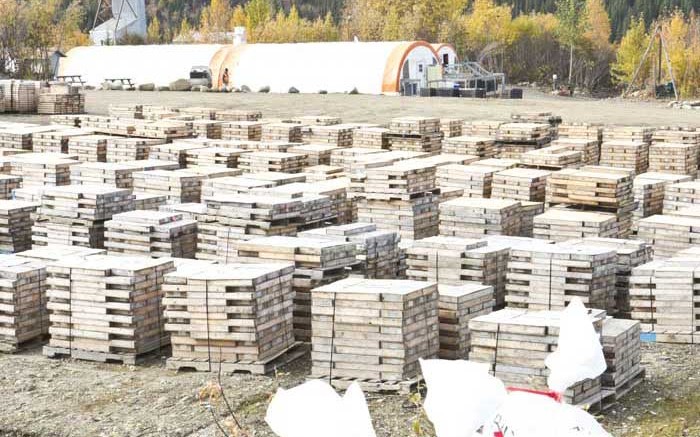NovaCopper (TSX: NCQ; NYSE-MKT: NCQ) will be coming out with an updated resource estimate for its Bornite carbonate-hosted copper deposit in northwestern Alaska before the end of March, and expects to kick off a prefeasibility study of Arctic, its copper–zinc–lead–silver volcanogenic-massive-sulphide deposit, before the end of June.
The two deposits — which are 26 km apart — make up part of NovaCopper’s Upper Kobuk project in Alaska’s Ambler district near Kobuk, a town of 150 people on the banks of the Kobuk River.
Haywood Securities has listed NovaCopper as one of 16 juniors that the brokerage’s analysts believe offer short-term investment opportunity, with strong management teams, prospective projects and sufficient funding or access to capital to produce news over the next few months.
Patrick Donnelly, NovaCopper’s vice-president of corporate communications, confirmed in an email from Vancouver that the company was debt-free and held $9.4 million in cash as of Aug. 31, 2013. And while he concedes that management “will eventually have to do a financing,” the company has “supportive shareholders who have indicated that they are in for the long-run.”
These investors, which together own 60% of the company’s stock, include: Henry Paulson; the Baupost Group, a hedge fund with offices in Boston and London; New York-based hedge fund Electrum Strategic Resources; money manager M&G investments; and Fidelity.
Donnelly says he would agree with Haywood’s assessment that the company has a strong management team given that it is headed by president and CEO Rick Van Nieuwenhuyse, who received the Thayer Lindsley award in 2009 for his role in the Donlin gold discovery, as well as founding NovaGold Resources (TSX: NG; NYSE-MKT: NG), which spun out NovaCopper in May 2012.
NovaCopper’s Alaskan projects are also high grade, he says.
“We have some of the highest copper grades in the world — Arctic has a copper-equivalent grade of 6% copper, and Bornite has grades between 0.8 and 2.5% copper,” Donnelly continues. “Having high grades means that we don’t need to spend billions of dollars to build a mine. It also results in low cash costs.”
A future mine at the flagship Arctic deposit would have a cash cost of US62¢ per lb., which he says would be “one of the lowest cash costs in the copper space,” adding that one-third of the revenues would come from zinc, a metal that he claims “most analysts are expecting” to be in “severe” shortage within the next couple of years.
Indicated resources at Arctic stand at 23.8 million tonnes grading 3.26% copper, 4.45% zinc, 0.76% lead, 0.71 gram gold per tonne and 53.2 grams silver per tonne, while inferred resources add 3.4 million tonnes grading 3.22% copper, 3.84% zinc, 0.58% lead, 0.59 gram gold and 41.5 grams silver.
At its Bornite deposit, the Ruby Creek zone has indicated resources of 6.8 million tonnes grading 1.19% copper and inferred resources of 47.7 million tonnes grading 0.84% copper, while the South Reef zone of Bornite has an inferred resource of 43.1 million tonnes grading 2.54% copper.
NovaCopper announced additional assays from exploration drilling at Bornite at the end of 2013 that it says suggest the two zones might be linked, which could increase the scale and economics of any future operation.
At Arctic, an updated preliminary economic assessment completed in July 2013 outlined a 10,000-tonne-per-day open-pit operation that would produce 125 million lb. copper, 152 million lb. zinc and precious metals over a 12-year mine life. The study concludes that the project would generate an after-tax net present value at an 8% discount rate of $537 million, and an 18% after-tax internal rate of return at US$2.90 per lb. copper, US85¢ per lb. zinc, US90¢ per lb. lead, US$22.70 per oz. silver and US$1,300 per oz. gold.
Donnelly points to some of NovaCopper’s other attributes — which include the project’s location in Alaska, which it says is “one of the most stable mining jurisdictions in the world” — and the junior’s strong relations with the NANA Regional Corp., which is a native-owned corporation.
NANA was set up as a for-profit operation in 1971, and today has more than 13,500 Inupiat shareholders, with roots in northwestern Alaska. In 1982, the corporation and Teck Resources (TSX: TCK.B; NYSE: TCK) developed the Red Dog zinc mine under an innovative operating agreement. The NANA region encompasses 38,000 square miles, most of which is above the Arctic Circle, and includes 11 villages: Ambler, Buckland, Deering, Kiana, Kivalina, Kobuk, Kotzebue, Noatak, Noorvik, Selawik and Shungnak.
Under the terms of NovaCopper’s agreement with NANA, the corporation is to receive a net smelter return royalty of 1–2.5%, and has the option to participate as an equity partner (16–25%), or receive a net-proceeds royalty.
“Many of our peers have issues with First Nations and other indigenous groups,” Donnelly says. “NovaCopper’s management has considerable experience and success in working with First Nations and earning a social licence.”
Over the last year, NovaCopper’s shares have traded within a 52-week range of $1.45 to $2.20. They closed at $1.65 per share on Jan. 15. The company has 53 million shares outstanding.


Be the first to comment on "NovaCopper prepares for a big year"